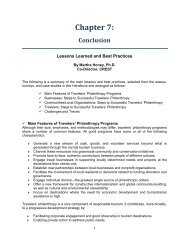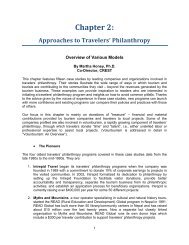Do's and Don'ts of Travel Giving - Travelers' Philanthropy
Do's and Don'ts of Travel Giving - Travelers' Philanthropy
Do's and Don'ts of Travel Giving - Travelers' Philanthropy
You also want an ePaper? Increase the reach of your titles
YUMPU automatically turns print PDFs into web optimized ePapers that Google loves.
Managing <strong>Travel</strong>ers’ Expectations:Do’s <strong>and</strong> Don’ts <strong>of</strong> <strong>Travel</strong> <strong>Giving</strong>Willliam H. DurhamCo-Director, CREST &Sr. Fellow, Woods Institute for EnvironmentStanford
Managing <strong>Travel</strong>ers’ Expectations:Do’s <strong>and</strong> Don’ts <strong>of</strong> <strong>Travel</strong> <strong>Giving</strong>
<strong>Philanthropy</strong><strong>and</strong> Responsible <strong>Travel</strong>1. Where does philanthropy fit in?2. Who or what does it benefit?3. How to make the most <strong>of</strong> it?4. Practical “dos <strong>and</strong> don’ts”
<strong>Philanthropy</strong><strong>and</strong> Responsible <strong>Travel</strong>1. Where does philanthropy fit in?Among many forms <strong>of</strong> Responsible <strong>Travel</strong>,focus for a moment on:Ecotourism
NGO orcompanyLocal PeopleNaturalAttractionEcotourismProject
Inputs from all 3 components:NGO orcompanyNaturalAttractionLocal PeopleEcotourismProjectRevenue
NGO orcompanyNaturalAttractionLocal PeopleOrganizationalneeds:Return on InvestmentSalaries, etc.EcotourismProjectRevenueLocal needs:TrainingInfrastructureL<strong>and</strong> tenureConservation
NGO orcompanyNaturalAttractionLocal PeopleOrganizationalneeds:Return on InvestmentSalaries, etc.EcotourismProjectRevenueLocal needs:TrainingInfrastructureL<strong>and</strong> tenureConservation<strong>Philanthropy</strong>
NGO orcompanyNaturalAttractionLocal PeopleOrganizationalneeds:Return on InvestmentSalaries, etc.EcotourismProjectRevenueLocal needs:TrainingInfrastructureL<strong>and</strong> tenureConservation<strong>Philanthropy</strong>
NGO orcompanyNaturalAttractionLocal PeopleOrganizationalneeds:Return on InvestmentSalaries, etc.EcotourismProjectRevenueLocal needs:TrainingInfrastructureL<strong>and</strong> tenure<strong>Philanthropy</strong>Conservation
In this example, 3 waysphilanthropy fits in:1. Can help with conservation: contributingto the environmental health <strong>of</strong> the location.2. Can help with local needs: contributingto livelihoods, training, infrastructure, etc.3. Can help the NGO or company: helpingwith its costs, skills, <strong>of</strong> administration.In most cases, visitors prefer #1 or #2
<strong>Philanthropy</strong><strong>and</strong> Responsible <strong>Travel</strong>1. Where does philanthropy fit in?2. Who or what does it benefit?3. How to make the most <strong>of</strong> it?4. Practical “dos <strong>and</strong> don’ts”The hardest question: How to makethe most <strong>of</strong> generous impulses….
Phil-anthropy• Loving humanitythrough giving• Expressing love bygiving away part <strong>of</strong>oneself• Two BIG intrinsicissues:– Expressing strongemotion– Problems <strong>of</strong> “TheGift”
• “A gift is never free”(a gift is rarely free)• Two entanglements:– Identity: gifts areabout us; especiallymeaningful to thegiver– Expectations:something is (almostalways) wanted back• “Gifts convey power”(they are “loaded”)Marcel Mauss
In light <strong>of</strong> these issues:THE GOAL IS“Mindful<strong>Giving</strong>!”• Honoring theimpulse to give & tohelp…• in a thoughtful,deliberative way.• Recognize the power<strong>of</strong> the gift• And “work it” to dothe most good!
• So now my own little synopsis from• Crest’s “<strong>Travel</strong>er’s <strong>Philanthropy</strong>H<strong>and</strong>book” edited by Martha Honey• With an emphasis on owners & operators
DON’T:DO:1. Don’t even think aboutspontaneous h<strong>and</strong>outs --your own OR guests.2. Don’t fall for “r<strong>and</strong>omacts <strong>of</strong> kindness” that domore harm than good.3. Don’t be fooled: thereare few “quick fixes.”1. Do consider mindfulways to give back todestinations.2. Do explore ways thatgifts can make apositive difference.3. Do realize that time <strong>and</strong>lasting commitment arerequired!
DON’T:DO:1. Don’t try to save theday (or be “heroic”!)2. Don’t assumecommunities arecoherent <strong>and</strong> simple.3. Don’t follow your ownlist <strong>of</strong> needs & wants(no matter how clear).4. Don’t assume you knowthe best way forward.1. Do engage with thelocal community (-ies).2. Do work to underst<strong>and</strong>all players/stakeholders<strong>and</strong> their roles.3. Do listen carefully to(diverse) communityneeds & wants.4. Do allow the communityto decide what, when, &how.
DON’T:DO:1. Don’t imagine you canimplement changes –try to be a catalyst.2. Don’t assume you arethe best partner for thecommunity…3. Don’t make or becomeyour own NGO withoutcareful consideration.1. Do work to empowerthe community (-ies) toimplement changes.2. Do consider partneringwith an NGO that has agood track record.3. Do try to strengthen &help existing localorganizations
DON’T:DO:1. Don’t let guests set thecourse or determineyour approach...2. Don’t treat yourphilanthropic efforts asa separate activity.3. Don’t “show <strong>of</strong>f” yourprogram, which canobjectify people…1. Do show by examplehow your localcommitment works.2. Do work to integratephilanthropic efforts intovisitors’ experience.3. Do find ways t<strong>of</strong>acilitate exchange <strong>and</strong>mutual learning.
DON’T:DO:1. Don’t feel you have toaccept ALL gifts (or thatyou can’t steer them…)2. Don’t get eager! Betterresults if requests arethoughtful, subtle, <strong>and</strong>“quietly convincing.”3. Don’t overdo it:remember that “show<strong>of</strong>f” is “turn <strong>of</strong>f!”1. Do provide a range <strong>of</strong>giving options, withexplanations for each.2. Do find indirect ways(bulletin boards, onlineinfo, guides) to explainwhat you do & why;3. Do make T Phil anatural, integral part <strong>of</strong>your tourism product.
In this tourism business,if we are not really careful with philanthropy…stuff happens!
Because we are talking “gifts”…• Which are rarely free• But come with twoentanglements:– Identity: gifts areabout us; especiallymeaningful to thegiver– Expectations:something is (almostalways) wanted back• We must be verycareful!
Can even think <strong>of</strong> philanthropy as sharkinfested waters!And we’re the surfer!
It is especiallyimportant to:
Anticipate effects <strong>of</strong> our choices!
Plan carefully ahead! Be mindful <strong>of</strong>intended <strong>and</strong> unintended consequences
Don’t wing it! Do the prep work <strong>and</strong>assessment required to do it well…
And even then, be modest & deliberativeDon’t <strong>of</strong>fer the Moon!!
SomeBest PracticesAgain, from owners & operators perspective;extracted fromCREST’s <strong>Travel</strong>ers’ <strong>Philanthropy</strong> H<strong>and</strong>book
The real deal – the 4 c’s <strong>of</strong> genuine<strong>Travel</strong>er’s <strong>Philanthropy</strong>:1. It’s considerate, requiring carefulassessment <strong>of</strong> local resources & needs;2. It’s commitment: a “program” more than a“project;” think <strong>of</strong> it as systematic, integral;3. It’s cumulative, long-term, not year to year:plan for 5 to 10 years to make a difference;4. It’s collaborative, requiring engagement with<strong>and</strong> dedication to the community;
Steps to Success in T. Phil.1. Know the community, its resources as wellas its needs & weaknesses;(Hint: play to its strengths)2. Consider carefully your company’s capacity<strong>and</strong> commitment!(Hint: avoid spreading too thin; stay modest)3. Create a marketing strategy that includesphilanthropy as part <strong>of</strong> who you are;(Hint: include T Phil program on your website)
Steps to Success in T. Phil.4. Include experience with philanthropic effortsas part <strong>of</strong> your product;(Hint: make sure staff & guides “get it”)5. Requests should not be “asks” but “<strong>of</strong>fers,”allowing clients to “co-invest” with you!(Hint: be indirect & subtle, use printed media)6. Keep fellow co-investors in the loop: begin aprogram <strong>of</strong> stewardship & information;(Hint: consider a newsletter & tailored emails)
Steps to Success in T. Phil.7. Ensure ongoing accountability: h<strong>and</strong>ledonated funds separately, via NGO etc.(Hint: make sure they are tax-deductible)8. Diversify funding sources over time, to reducedependence on a set <strong>of</strong> donors;(Hint: could the program become its own communitybusinesssome day?)9. Enjoy <strong>and</strong> communicate successes, but bemodest about it!
Appropriate <strong>Philanthropy</strong>:1. Not impulsive, but reflective2. Seeks appropriate intermediaries3. Plans for maintenance, continuity4. And will still have unintended effectsSome domains to consider:(1) Health(2) Education(3) Cultural revitalization(4) *L<strong>and</strong> Tenure*
¡Mil gracias!















